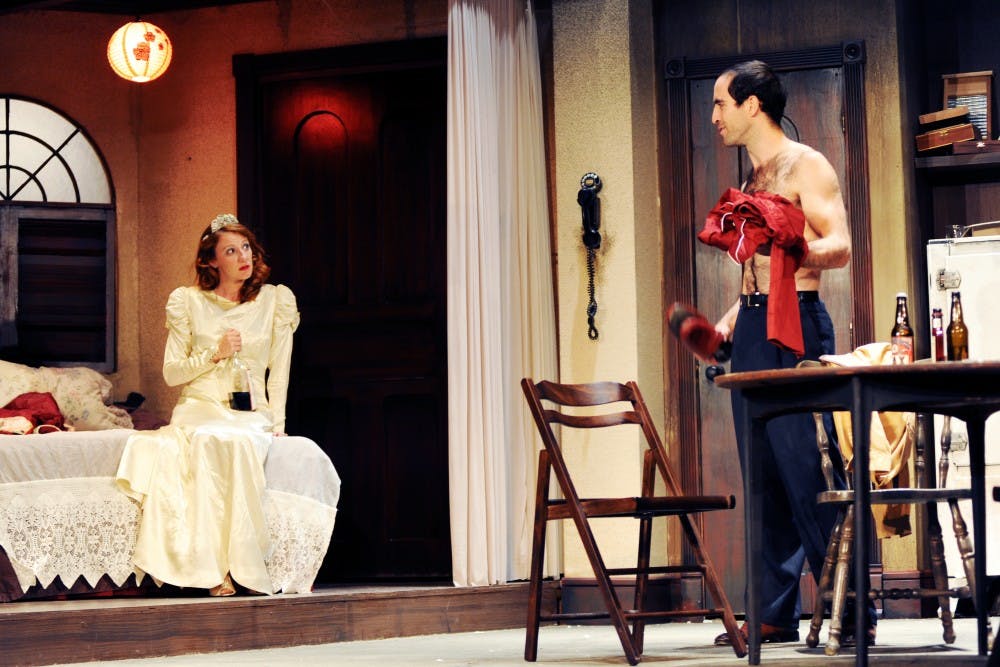Re-imagining classics of American literature like Tennessee Williams'"A Streetcar Named Desire" is not an easy task. Years, even decades of performance establish precedents and norms for how the plays should be adapted to the stage. To keep a performance fresh is a feat that takes months of preparation from minds who are given free reign to incorporate their own streaks of originality.
Members of the ASU School of Film, Dance and Theatre took on the challenge of bringing this classic play to the modern stage. MFA in directing student Wyatt Kent took up the chair of director for bringing this play to life at Lyceum Theatre.
The stage design team worked closely together to ensure that the set, the lighting, the sound and the stage effects brought the play up to date for contemporary theatre.
One interesting design aspect unique to this staging of the play was the work of Michael Bateman, media designer for the play, who introduced projected visuals onto the stage to reflect the changing and conflicting mind states of the character Blanche.
"(Williams) writes things like 'lurid reflections appear on the wall' and 'sinuous shadows seem as though they're attacking Blanche'"' Bateman said. "So the design team as a whole decided that projections fit in this world we just have to be very careful with how it fits in there."
Bateman worked closely to the script to maintain integrity for choosing to employ visuals into the stage design.
"As we progress through the play we see her dissociating from reality and attaching herself to things in the past and we see these things latching to her," he said. "It's about how her past is fracturing her reality."
Bateman said he hopes that media like projecting visuals can be used more and more in the stage world and for this play the success of it's integration involved careful readings and a close-knit team.
"If you're careful and you read the script and work as a design team you can pull out something that’s unique and new that will make the show be really beautiful."
Scenic designer Tyler Scrivner was excited to work on a play which bears an established spot in the American literary canon. At first reading of the play he knew that he wanted to do something original with the set design.
"I intentionally tried to avoid looking at how other people had done it," he said. "I really wanted to go off how I interpreted the script."
So Scrivner only paid attention to how other people set up the technical aspects of the stage, allowing all of his details and color choices to be completely independent from how other designers had tackled it in the past. After doing the design he did go back to compare what he came up with with other past stagings of the play. What he found was that, although he had no exposure to any of them, his design was still similar.
"My interpretation fits what a lot of people have come to expect from 'Streetcar' but is still different enough for it to be interesting and original to look at," he said.
Lighting designer Jamie Arakas said he used personal influences that came into fruition in this play.
"I draw a lot of inspiration from magic realism, which mainly seeks to tell us to find one thing that is extraordinary within the ordinary," he said.
The immaculate acting of the cast was unduly overshadowed in the context of this write-up due to the concentration on the design of the play. Do not let this dissuade you reader, as the actors and actresses are well-rehearsed, nail their lines every time and overall are simply impressive. However, the design of this staging of "A Streetcar Named Desire" is worth the trip to the theatre in itself.
So much so that I'm planning a second trip to the Lyceum Theatre just to experience this version of "Streetcar" again.
The show runs until Sunday, Oct. 25, and you can buy your tickets here.
Related links:
Phoenix Poetry Series keeps downtown Phoenix beat scene ablaze at {9} The Gallery
Judge these books by the cover: 'Overbooked' proves book-binding isn't over
Reach the reporter at lsaether@asu.edu or follow @looooogaaan on Twitter.
Like The State Press on Facebook and follow @statepress on Twitter.




